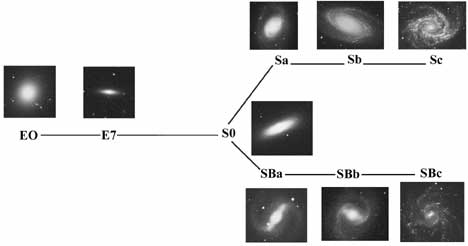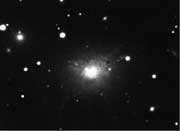The Hidden Lives of Galaxies - Characteristics of Galaxies
I. The Visible Lives of Galaxies
A. The Characteristics of Galaxies
Like all galaxies, the Milky Way is held together by gravity. Gravity also holds the stars, planetary bodies, gas, and dust in orbit around the center of the galaxy. Just as the planets orbit around the Sun, the Sun orbits around the center of the Milky Way.
Galaxies come in a variety of shapes. In the 1920's Edwin Hubble was the first to study the morphology of galaxies. Using the 100-inch Hooker reflector telescope at Mount Wilson Observatory in California between 1922-1926, Hubble photographed numerous galaxies. He categorized (or "classified") their shapes as spiral, barred spiral, elliptical, irregular, and peculiar. This system was known as the Hubble morphological sequence of galaxy types.
Hubble noted that some galaxies, like the M31- Andromeda Galaxy, appeared as disks and had arms of stars and dust which appeared in a spiral pattern. Like M31, these galaxies appeared nearly uniform in brightness. In addition, Hubble observed that in some of these types of galaxies the arms were more tightly wound around the galaxy. He called these spiral galaxies. Our Galaxy, the Milky Way, is an example of a spiral galaxy.
Hubble also noted that some spirals had a bright bar of gas through the center, and called these barred spirals. Hubble also discovered galaxies that were slightly elliptical in shape, while others were nearly circular, such as M32. He called these elliptical galaxies. The fourth type of galaxy observed was neither spiral nor elliptical, but was irregular in shape. These galaxies were called irregular. An example of this is the Magellanic Clouds. Finally, there were some galaxies that fit none of these descriptions. These were called peculiar galaxies, one example of which is Centaurus A.
This classification sequence has become so widely used that the basic types, spiral, barred spiral, elliptical, irregular, and peculiar, are still used by astronomers today to classify galaxies according to their visible appearance. Spirals are denoted by "S", and barred spirals by "SB". Letters "a", "b", "c" denote how tightly the spiral arms are wound, with "a" being most tightly wound. The Andromeda Galaxy is an Sb. Elliptical galaxies are denoted by "E", with a number from 0-7 indicating how circular it appears (0 being most circular, 7 being more elongated). An example of this would be M87, which is an E0 galaxy. Irregulars, such as the Small Magellanic Cloud, are denoted by "Irr". Peculiar galaxies, such as Centaurus A, are denoted by "P".
To show how the various classes relate to each other, Hubble organized them into a diagram. A simplified version of Hubble's Fork Diagram is shown below. Note that this diagram does not represent how galaxies form.

|
| Hubble's Fork Diagram of Galaxy Classification |
Astronomers now have recognized that the morphology classification consists of two basic types of galaxies: the spirals and the ellipticals. Barred spirals are a subclass of spirals. Irregulars may be either spiral or barred spiral. Peculiars are not fundamentally a different type. They are simply galaxies in the act of colliding; the collision distorts their shape and makes them appear "peculiar".

|
| Seyfert Galaxy NGC 1275 in Persus |
Later, astronomers added other classifications. One of these astronomers was Carl Seyfert. In 1943, he discovered galaxies with very bright central regions. Seyfert studied the spectra of these galaxies. The spectra indicated that the central region was bright at all wavelengths. This indicated some enhanced activity, and "Seyfert" galaxies became the first of a range of active galaxies that have been studied at all wavelengths since then.
Recommended Activities: Identifying Galaxies and Classifying Galaxies Using Hubble's Fork Diagram

